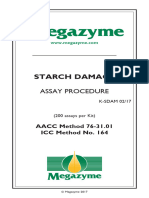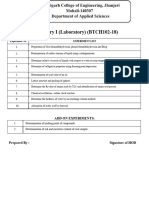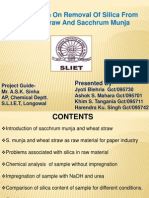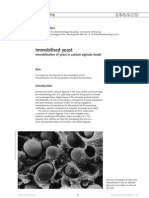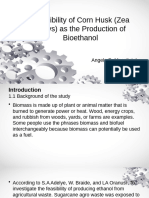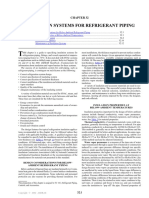Biodegradable Films: Based On Partially Hydrolyzed Corn Starch or Potato Starch
Biodegradable Films: Based On Partially Hydrolyzed Corn Starch or Potato Starch
Uploaded by
Ujak KimiaCopyright:
Available Formats
Biodegradable Films: Based On Partially Hydrolyzed Corn Starch or Potato Starch
Biodegradable Films: Based On Partially Hydrolyzed Corn Starch or Potato Starch
Uploaded by
Ujak KimiaOriginal Description:
Original Title
Copyright
Available Formats
Share this document
Did you find this document useful?
Is this content inappropriate?
Copyright:
Available Formats
Biodegradable Films: Based On Partially Hydrolyzed Corn Starch or Potato Starch
Biodegradable Films: Based On Partially Hydrolyzed Corn Starch or Potato Starch
Uploaded by
Ujak KimiaCopyright:
Available Formats
Biodegradable Films
Based on Partially Hydrolyzed Corn Starch or Potato Starch
Herbert Sommerfeld and Rijdiger ~ l u m e '
Department of Chemical Education, University of Bielefeld,D-4800 Bielefeld 1, Germany
Renewable raw materials are gaining increasing import- gen bonds between the long-chain, unbranched amylose
ance as starting materials for chemical syntheses (13). molecules. The more-globular amylopectin, which disturbs
Applications that lead to ecologically compatible products the crystalline order, improves the strength. However, the
are becoming especially interesting. high brittleness due to amylopectin binders the commer-
cial application of simple starch films.
The Need for Biodegradable Films Nevertheless, the chemical derivation of native starch
An important renewable raw material is biopolymer and the addition of nontoxic plasticizers can both be used
starch. One of the basic properties of starch is its film- to manufacture films that show satisfactory tensile
forming ability. In developing chemical modifications that strength, flexibility,and transparency for multipie applica-
improve upon this natural ability for industrial and house- tions (e.g., as packaging materials). Small molecules that
hold applications, attention should be paid to whether the form hvdroeen bonds with starch. such as water or alco-
products retain the original biodegradability (4,5).Thus, it hob, afread; exhibit plasticizer effects. However, water or
is advantageous to preserve the native molecular structure simple alcohols can not be used satisfactorilv in this a o ~ l i -
of the starch molecule as much as possible so that decom- cat& due to their high volatility. A better cioice is a 'defi-
position by enzymes can still occur. nite polyol (e.g., glycerol).
Conventionalpolyolefm films constitute about 2% of nor- Since they have a high content of hydrophilic alcoholic
mal household waste, and thus create a disposal problem hyclroxyl gmups, starch films (in contrast to hydrophobic
if they are not recycled or incinerated (6).Several unsuc- polyolefin films) may be colored with water-soluble food
cessful attempts have been made to improve the photooxi- colors without exceeding the limiting values for food addi-
dative decomposition of polyolefin films that do not un- tives established by WHO (9).Films consisting of starch,
dergo biological degradation. The development of glycerol, and food colors are completely nontoxic.
biodegradable films has made a considerable contribution
to the protection of the environment. Thus, the prepara- The aualitv of starch films is hiehlv dependent on the
tion of starch-based films is a very promising field of re- ratio ofamyiose to amylopectin a n i o n th/average molec-
search (7). ular weight of the starch. A large percentage of
Demonstration of the promising developments in starch amylopedin (M, = lo6 to 2 x lo7)is as &advantageous as
chemistry can be done with short and relevant classroom a high content of amylose (M, = 4 x lo4 to 2 x lo5). The
experiments. Such experiments are useful in encouraging acid-catalyzed partial hydrolyzation of native starch can
not only the students' interest in chemistry, but also their achieve two mals: decrease the amvlopedin content and
participation in interdisciplinary discussions of related bi- decrease of the average molecular weiiht. The hydrolysis
ological, toxicological, ecological, and economical prob- of the helical amylose molecules is slow compared to the
lems. hydrolysis of amilopectin.
Tensile streneth can be imoroved bv addim comwnents
Improving the Quality of the Films that cause furtger cross-liAng. An ekample?s diaidehyde
Most corn, potato, and wheat starches comprise starch. which is obtained bv oxidizing starch with sodium
amylopedin at 7045% and amylose at 15-30% (8).The rneta-periodate (10). Films that contgn dialdehyde starch
film-forming ability of starch is principally due to hydro- are still biodegradable. (Continued on page A152)
Volume 69 Number 5 May 1992 A151
The Modern Student laboratory:
Exploring the Environment
Experimental Section Equipment
Experiment 1: Preparation of Starch-Based Films flask (100 mL)
magnetic stimr
Required time: 20 min and 1day (for desiccation). dropping funnel
filtering material
Equipment beaker (100 mL)
f l a s k (100 mL)
heatable magnetic stirrer Reagents
oil bath cam starch (MerckNo. 11686.0250)
'thermometer or potato starch (Merck No. 1259.0250)
.plastic sheet (acrylic glass, about 15 x 15 cm2) solution of glycerol in water (50 ~01%)
4 pipets (2 mL, 3 mL, 20 mL, and 25 mL) distilled water
desiccator cabinet, if available sodium me&-periodate(Merck No. 6597.0050)
Reagents Procedure
corn starch (Merck No. 11686.0250) A solution of 5.1 g sodium meta-periodate in 65 mL of
or potato starch (Merck No. 1259.0250) distilled water is slowly added over a period of 1 h to a
solution of glycerol in distilled water (50 vol%) stirred mixture that contains 4 g of starch in 20 mL of dis-
distilled water
solutions of food colors in water (1 g1100 mL) tilled water. (When potato starch is used, 25 mL of distilled
patent blue (Fluka No. 76270) water is needed.)
new-coccine, also called cochineal red (Aldrich No. 19.973-7) The mixture should be stirred for a n additional 24 h a t
hydrochloric acid (0.1mom) 20 'C and then filtered. The residue must be washed three
solution of sodium hydroxide in water (0.1mollL) times with water to remove ionic com~onents.
~
The wet dialdehyde starch mixture, which weighs about
Pmcedure 11-.e. is about 754 water. The undried oroduct will be used
The following ingredients are heated in a flask for ex- in Experiment 4.
actly 15 min a t 1 0 5 1 1 0 'C and stirred until a homoge-
neous mixture is formed.
2.5 g of corn starch (or 2.5 g of potato starch) Experiment 3: Films with Additional Dialdehyde Starch
2 mL of glycerol solution
0.2-1 mL of food color solution Required time: 20 min and 1day (for desiccation).
3 mL of diluted hydrochloric acid Equipment
'20 mL of distilled water (with potato starch, 25 mL)
Identical to that used in Experiment 1.
The hot viscous solution is neutralized by the addition of
3 mL of dilute sodium hydroxide solution. Then it is poured Reagents
on a plastic sheet and dried in a desiccator cabinet a t 100- Identical to those used in Experiment 1,with the addi-
110 'C for about 1.5 h. After desiccation, a colored, high- tion of the dialdehyde starch obtained in Experiment 2.
quality starch film can be removed from the sheet. The
drying-time dependson the thickness of the film and Procedure
should be observed. The procedure is similar that used in Experiment 1,
except that the 0.5 g of starch are replaced with 2 g of wet
Experiment2: Preparation of Dialdehyde Starch dialdehyde starch. The resulting film exhibits improved
Required time: 60 min on day 1,and 20 min on day 2. strength.
Caution:Sodium meta-periodate is oxidizing and it is com-
bustible. Handle it with care, as recommended by the manu- Acknowledgment
facturer. Dialdehyde starch can be harmful to humans. We thank our collaborators Anja Bergmam and Michael
Handle with care. Kiinsebeck for preparing several starch derivatives and
T h e following scheme illustrates t h e formation of the BASF AG for the friendly donation of food colors.
dialdehyde starch.
Literature Cited
1. Noturwlss. Unfwr (Chmie): Bader,H. J.;Blume,R.,Eda.:1989.47.
2. Sommexfeld. H.:Biume, R.; Bader, H. J.Pror Nofunoh. (Chnie) 1990,2,28-33.
3. Blume. R.: Bader. H. J. Umadfchemls im Emolmmnt: Srnotor:Ran!&rt. 1989.
ion, 1976.
hiatiq R. Bemiller, J. N.:Paschall, E. F. Starch--ChemlsIry and ?kchnalagy;
nis Ress: New York, 1984.
1'8 Eneyclopodio oflndusbial chemistry: Gerhartz, W , Ed.: Weinheim,
. .
Debold, Germany, 1990.
8. Carrer. C. E.: Seymour, R. B. J Chm. Educ. ISM, 64,314318.
9. Bader, H. J.; Some.rfeld. H. Pror Notunuisa. (Chamlsj 1988,3,1&20.
10. Mdhods in Corbohydmte chemistrv: Whistler, R. L., Ed.:Academic Preaa: New
A152 Journal of Chemical Education
You might also like
- AOAC 994.10 - GC - Cholesterol in Foods PDFDocument2 pagesAOAC 994.10 - GC - Cholesterol in Foods PDFdennisaberliani100% (2)
- Decorative Chrome Electroplated Part Performance WSS-M1P83-E2 Requirements, Abs or Pc/Abs Substrates, General Exterior Use 1. ScopeDocument20 pagesDecorative Chrome Electroplated Part Performance WSS-M1P83-E2 Requirements, Abs or Pc/Abs Substrates, General Exterior Use 1. ScopeFrancesco VignaliNo ratings yet
- 45.4.10 AOAC Official Method 994.10 Cholesterol in Foods: C) D) E) F) G) H)Document11 pages45.4.10 AOAC Official Method 994.10 Cholesterol in Foods: C) D) E) F) G) H)Angélica VargasNo ratings yet
- Propofol SynthesisDocument8 pagesPropofol SynthesisGiorgos Doukas Karanasios0% (1)
- Polymers Homework1 1Document4 pagesPolymers Homework1 1mike100% (1)
- Alup 2016 ZipDocument80 pagesAlup 2016 Zipluis0% (1)
- HAZOP Training GuideDocument12 pagesHAZOP Training GuideanonymousNo ratings yet
- Use of Rice Straw and Radiation-Modified Maize Starch/acrylonitrile in The Treatment of WastewaterDocument12 pagesUse of Rice Straw and Radiation-Modified Maize Starch/acrylonitrile in The Treatment of Wastewaterdeni.sttnNo ratings yet
- TJPS 19 153Document8 pagesTJPS 19 153Korsa SandrinaNo ratings yet
- Stenochlaena Palustris Flour and Poly (Vinyl Alcohol) : Development of Antioxidant Film Based On Blends ofDocument14 pagesStenochlaena Palustris Flour and Poly (Vinyl Alcohol) : Development of Antioxidant Film Based On Blends ofRina YeohNo ratings yet
- Evaluation of The Effects of Additives On The PropDocument13 pagesEvaluation of The Effects of Additives On The Propรђคภภєɭ ⟭⟬No ratings yet
- Fiber 01Document4 pagesFiber 01Kim-Kim TorresNo ratings yet
- Influence of The Oxidation and Acetylation of Banana FilmDocument8 pagesInfluence of The Oxidation and Acetylation of Banana FilmDaniel MartínezNo ratings yet
- Molecular Characterization of Sorghum Using RAPD and ISSR MarkerDocument12 pagesMolecular Characterization of Sorghum Using RAPD and ISSR Markersaikripa121No ratings yet
- Enzymatic Saccharification and Fermentation of CelDocument10 pagesEnzymatic Saccharification and Fermentation of CelSharmaNo ratings yet
- A Simple Method For Derivatizing The Surface of Silica Gel With Aldehyde Groups by Employing A New Alkoxy Aldehyde SilaneDocument14 pagesA Simple Method For Derivatizing The Surface of Silica Gel With Aldehyde Groups by Employing A New Alkoxy Aldehyde Silanerashmi chauhanNo ratings yet
- Lab2 Solids DeterminationDocument14 pagesLab2 Solids DeterminationsadoonNo ratings yet
- Production of α-amylase using new strain of Bacillus polymyxa isolated from sweet potatoDocument7 pagesProduction of α-amylase using new strain of Bacillus polymyxa isolated from sweet potatoInternational Organization of Scientific Research (IOSR)No ratings yet
- Chemistry Investigatory Project 12TH Bioplastic Out of Potato StarchDocument16 pagesChemistry Investigatory Project 12TH Bioplastic Out of Potato Starchst.8b.vedangrathodNo ratings yet
- Slide BIOPOLIMERDocument93 pagesSlide BIOPOLIMERJesa FradaNo ratings yet
- K-Sdam DataDocument12 pagesK-Sdam Data2nmzgbvk6cNo ratings yet
- EContent_2_2024_07_30_09_28_47_LabMAnualpdf__2024_07_09_14_45_00Document48 pagesEContent_2_2024_07_30_09_28_47_LabMAnualpdf__2024_07_09_14_45_00madhavgarg152No ratings yet
- Campylobacter4 PDFDocument15 pagesCampylobacter4 PDFmohammednazeerNo ratings yet
- Development of Cellulose Based Bioplastic From Corn Stalks PDFDocument6 pagesDevelopment of Cellulose Based Bioplastic From Corn Stalks PDFMaki SchicksalNo ratings yet
- Revised C3-C5Document23 pagesRevised C3-C5Clarissa AlfaroNo ratings yet
- Investigation of The Gelatinization and Extrusion Processes of Corn StarchDocument8 pagesInvestigation of The Gelatinization and Extrusion Processes of Corn StarchRobertaSouzaNo ratings yet
- J. A. K. H.Document33 pagesJ. A. K. H.Ashok MaharaNo ratings yet
- Antioxidants AOACread FileDocument4 pagesAntioxidants AOACread FileZacariasNo ratings yet
- Temperature Influence in Cornstarch Gelatinization For Froth FlotationDocument5 pagesTemperature Influence in Cornstarch Gelatinization For Froth FlotationRougeeeNo ratings yet
- Urea FormaldehidDocument4 pagesUrea FormaldehidBening DwipermataNo ratings yet
- Rice Hull To Kojic AcidDocument17 pagesRice Hull To Kojic AcidArrianne Jaye MataNo ratings yet
- E Ect of Aluminum Sulfate and Cationic Polyelectrolytes On The Destabilization of Emulsi®ed WastesDocument8 pagesE Ect of Aluminum Sulfate and Cationic Polyelectrolytes On The Destabilization of Emulsi®ed WastesmahirgaNo ratings yet
- Chemindix. Nanocellulose From Date Palm TreesDocument12 pagesChemindix. Nanocellulose From Date Palm TreesA AlhamzaniNo ratings yet
- Fungal AmylaseDocument8 pagesFungal AmylaseangelinaanavarroNo ratings yet
- Immobilised Yeast: NCBE, University of ReadingDocument5 pagesImmobilised Yeast: NCBE, University of ReadingVipin ChandranNo ratings yet
- Intended Use: Periodic Acid-Schiff (Pas) Staining SystemDocument2 pagesIntended Use: Periodic Acid-Schiff (Pas) Staining SystemCollins Adjei-MensahNo ratings yet
- CHEM3011-Expt 4-Polymerization of TPA InstructionsDocument7 pagesCHEM3011-Expt 4-Polymerization of TPA InstructionsJune JamNo ratings yet
- Amylose/ Amylopectin: Assay ProcedureDocument12 pagesAmylose/ Amylopectin: Assay ProcedureAdriannah AdrianNo ratings yet
- Jsir 76 (2) 105-109Document5 pagesJsir 76 (2) 105-109Div SavaliyaNo ratings yet
- Enzymatic Hydrolysis of Chemithermomechanically Pretreated Sugarcane Bagasse and Samples With Reduced Initial Lignin ContentDocument7 pagesEnzymatic Hydrolysis of Chemithermomechanically Pretreated Sugarcane Bagasse and Samples With Reduced Initial Lignin ContentbryanNo ratings yet
- Chemical Pretreatments of Corn Stover For Enhancing Enzymatic DigestibilityDocument15 pagesChemical Pretreatments of Corn Stover For Enhancing Enzymatic DigestibilityAdeniji AdetayoNo ratings yet
- Bioconversion of Posthydrolysed Autohydrolysis Liquors: An Alternative For Xylitol Production From Corn CobsDocument8 pagesBioconversion of Posthydrolysed Autohydrolysis Liquors: An Alternative For Xylitol Production From Corn CobsMaria Victoria Ortega RamosNo ratings yet
- Renewable Energy: I. Egüés, L. Serrano, D. Amendola, D.M. de Faveri, G. Spigno, J. LabidiDocument6 pagesRenewable Energy: I. Egüés, L. Serrano, D. Amendola, D.M. de Faveri, G. Spigno, J. LabidiRoshan GillNo ratings yet
- Cellulose Extraction and Quanti Cation From Eucalyptus Leaves in The LaboratoryDocument8 pagesCellulose Extraction and Quanti Cation From Eucalyptus Leaves in The LaboratoryDjouher GaadNo ratings yet
- Standard Procedure For Luminescence Vibrio FischeriDocument14 pagesStandard Procedure For Luminescence Vibrio FischeriCarlos DiazNo ratings yet
- Wastewater Treatment Lab TestDocument8 pagesWastewater Treatment Lab TesthuyNo ratings yet
- Alginate Beads Synthetic Bacteria That Affect: GrowthttDocument10 pagesAlginate Beads Synthetic Bacteria That Affect: GrowthttMelissa BakerNo ratings yet
- Materials and MethodsDocument29 pagesMaterials and MethodsleodanielamalrajNo ratings yet
- Comparative Study of Synthesis of Cellulose Propionate From Different Sources Using NIS As A New CatalystDocument18 pagesComparative Study of Synthesis of Cellulose Propionate From Different Sources Using NIS As A New CatalystBharath ChandranNo ratings yet
- Feasibility of Corn HuskDocument16 pagesFeasibility of Corn HuskAngela MacalintalNo ratings yet
- Bioresources.: Bioconversion of Bamboo To Bioethanol Using The Two-Stage Organosolv and Alkali PretreatmentDocument9 pagesBioresources.: Bioconversion of Bamboo To Bioethanol Using The Two-Stage Organosolv and Alkali Pretreatmentcandra ndraNo ratings yet
- Ethanol CalculationDocument14 pagesEthanol CalculationMuhammad Azim Khan NiaziNo ratings yet
- Word DocumentDocument7 pagesWord DocumentHlumelo SompondoNo ratings yet
- Partial C3-C5Document17 pagesPartial C3-C5Clarissa AlfaroNo ratings yet
- Experiment No. 4Document2 pagesExperiment No. 4Arun Uday ChaudharyNo ratings yet
- Ethanol Dehydration by Adsorption With SDocument6 pagesEthanol Dehydration by Adsorption With SANDREANo ratings yet
- XylitolDocument9 pagesXylitolElisa CorreaNo ratings yet
- Banana Peels Based Bio-PlasticDocument7 pagesBanana Peels Based Bio-PlasticJULISSANo ratings yet
- Alginte Beads FRMTNDocument8 pagesAlginte Beads FRMTNMeetika GuptaNo ratings yet
- Its Taro Related Studies Im DYING HERE, Its My First Time Doing Research and Ive Done It Solo, Maam Pls Put Me in A Taem PLEASEDocument6 pagesIts Taro Related Studies Im DYING HERE, Its My First Time Doing Research and Ive Done It Solo, Maam Pls Put Me in A Taem PLEASEjadeshades12No ratings yet
- KYBGLDocument13 pagesKYBGLWahyu Angga RizalNo ratings yet
- Plant and Animal Bio-Chemistry - Including Information on Amino Acids, Proteins, Pigments and Other Chemical Constituents of Organic MatterFrom EverandPlant and Animal Bio-Chemistry - Including Information on Amino Acids, Proteins, Pigments and Other Chemical Constituents of Organic MatterNo ratings yet
- Jurnal Kolokium - En.idDocument11 pagesJurnal Kolokium - En.idUjak KimiaNo ratings yet
- Primary Study of Cellulose Acetate Hollow FiberDocument7 pagesPrimary Study of Cellulose Acetate Hollow FiberUjak KimiaNo ratings yet
- Keith 1960Document17 pagesKeith 1960Ujak KimiaNo ratings yet
- Jurnal Rekayasa Kimia Dan Lingkungan: Jurusan Teknik Kimia, Fakultas Teknik Universitas Syiah KualaDocument1 pageJurnal Rekayasa Kimia Dan Lingkungan: Jurusan Teknik Kimia, Fakultas Teknik Universitas Syiah KualaUjak KimiaNo ratings yet
- AIP2016 - Morphostructure Analysis of Sapaya Ancient Volcanic AreaDocument8 pagesAIP2016 - Morphostructure Analysis of Sapaya Ancient Volcanic AreaUjak KimiaNo ratings yet
- IOP Conference Series - Materials Science and Engineering, Volume 1087, 2021 - IOPscienceDocument14 pagesIOP Conference Series - Materials Science and Engineering, Volume 1087, 2021 - IOPscienceUjak KimiaNo ratings yet
- Review Product:: Digital Sound Level MeterDocument1 pageReview Product:: Digital Sound Level MeterUjak KimiaNo ratings yet
- Desalination and Water TreatmentDocument11 pagesDesalination and Water TreatmentUjak KimiaNo ratings yet
- Polymer: Hewa Othman Ghareeb, Wolfgang RadkeDocument7 pagesPolymer: Hewa Othman Ghareeb, Wolfgang RadkeUjak KimiaNo ratings yet
- Concentration Polarization in Forward Osmosis Membranes - ForwardOsmosisTechDocument15 pagesConcentration Polarization in Forward Osmosis Membranes - ForwardOsmosisTechUjak KimiaNo ratings yet
- 2 PH Conductivity DoDocument3 pages2 PH Conductivity DoUjak KimiaNo ratings yet
- Anastopoloues-A Review For Coffee AdsorbentsDocument11 pagesAnastopoloues-A Review For Coffee AdsorbentsUjak KimiaNo ratings yet
- Comparison of Different Rice Straw Based Adsorbents For Chromium Removal From Aqueous Solutions - Desalination and Water Treatment - Volume 57, IssueDocument6 pagesComparison of Different Rice Straw Based Adsorbents For Chromium Removal From Aqueous Solutions - Desalination and Water Treatment - Volume 57, IssueUjak KimiaNo ratings yet
- Puri Cation of Biodiesel Using A Membrane ContactorDocument20 pagesPuri Cation of Biodiesel Using A Membrane ContactorUjak KimiaNo ratings yet
- Fuel Processing TechnologyDocument19 pagesFuel Processing TechnologyUjak KimiaNo ratings yet
- Es Q1 Mod2Document11 pagesEs Q1 Mod2Teacher Charlyn VlogNo ratings yet
- Cinnarizine SubDocument5 pagesCinnarizine SubSantosh VarmaNo ratings yet
- Epson Ink MsdsDocument5 pagesEpson Ink MsdsNIKKA MANAHAN100% (1)
- Ballarpur Institute of Technology Sessional Examination-I Applied Chemistry Time: 2Hrs Max Marks: 40 Section A Que.1Document3 pagesBallarpur Institute of Technology Sessional Examination-I Applied Chemistry Time: 2Hrs Max Marks: 40 Section A Que.1Praful KakdeNo ratings yet
- R02 - 32SI - Insulation System For Refrigerant Piping PDFDocument12 pagesR02 - 32SI - Insulation System For Refrigerant Piping PDFRatilal M JadavNo ratings yet
- Redox QsDocument8 pagesRedox Qspoocooloocoo172No ratings yet
- C09 Fact SheetDocument2 pagesC09 Fact SheetMohammad Ehsan EdalatNo ratings yet
- Aic 12556Document11 pagesAic 12556fajarNo ratings yet
- ISTEC 2011: Simulation and Optimization of Ethyl Acetate Reactive Packed Distillation Process Using Aspen HysysDocument6 pagesISTEC 2011: Simulation and Optimization of Ethyl Acetate Reactive Packed Distillation Process Using Aspen HysysAbdulwahab GIWANo ratings yet
- Ethylene Dichloride From Ethylene and ChlorideDocument4 pagesEthylene Dichloride From Ethylene and ChlorideThrese AreolaNo ratings yet
- Chemistry TricksDocument13 pagesChemistry Trickssajjad1ali-56No ratings yet
- Improved Shampoo Containing An Ester of Polyethylene Glycol, Urea or Thiourea and A PolysiloxaneDocument4 pagesImproved Shampoo Containing An Ester of Polyethylene Glycol, Urea or Thiourea and A Polysiloxaneali rezaeiNo ratings yet
- 04 Samss 002Document11 pages04 Samss 002hamedm1998100% (1)
- Umair. New CVVDocument2 pagesUmair. New CVVumair saeedNo ratings yet
- Expanded Mesh PDFDocument32 pagesExpanded Mesh PDFaahtagoNo ratings yet
- WilTec Hydraulic 12 Ton Press With ManometerDocument6 pagesWilTec Hydraulic 12 Ton Press With ManometerWaleed MuradNo ratings yet
- Coordination Set 1 - FCDocument1 pageCoordination Set 1 - FCPreeti JhaNo ratings yet
- Concrete Workability: CE F230 Civil Engineering MaterialsDocument25 pagesConcrete Workability: CE F230 Civil Engineering MaterialschirayuNo ratings yet
- Chlorosulfuric AcidDocument2 pagesChlorosulfuric AcidChristine Juliana CiembolonzNo ratings yet
- Test On Aggregates - 2Document7 pagesTest On Aggregates - 2SupreethNo ratings yet
- TUTORIAL 6 EditDocument4 pagesTUTORIAL 6 EditisfaNo ratings yet
- Carbopol 940 Polymer (SDS)Document12 pagesCarbopol 940 Polymer (SDS)virgilia sorianoNo ratings yet
- 69 ThapaB HPLCanalysis-Capsaicin JMedFood 2009 PDFDocument7 pages69 ThapaB HPLCanalysis-Capsaicin JMedFood 2009 PDFAshleyFigueraNo ratings yet
- Taylor Chloride Test KitsDocument2 pagesTaylor Chloride Test KitsFaustino BoteroNo ratings yet
- Flopaam FP Series PDFDocument1 pageFlopaam FP Series PDFandrea.cipagautaNo ratings yet
- Mass Transfer AssignmentDocument4 pagesMass Transfer AssignmentShanmugam GunasekaranNo ratings yet
- Emission Estimation Technique Manual AU 2012Document49 pagesEmission Estimation Technique Manual AU 2012János NegyeliczkyNo ratings yet




















